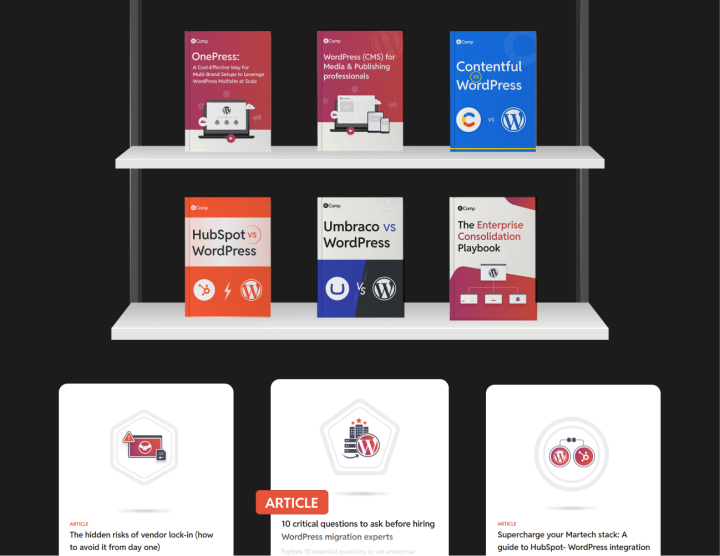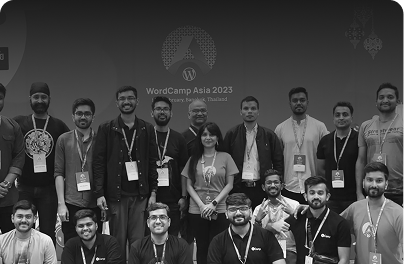Drupal vs WordPress: A detailed comparison

When it comes to open-source CMS solutions, it usually comes down to just two players: Drupal and WordPress. Both these CMSs are powerful, flexible, and built to adapt to a wide range of digital journeys.
While we work exclusively with WordPress here at rtCamp, we do believe both platforms have their place. That said, in most large-scale and enterprise scenarios, WordPress tends to be the better fit. Its ease of use and extensibility combined with the sheer size of its ecosystem ensures that enterprises can build fast, maintain with ease while staying close to the core, and scale efficiently even for their highly customized web stacks.
Still, selecting the right open-source CMS isn’t about declaring a winner—it’s about finding the best fit for your specific goals. And choosing between Drupal and WordPress requires careful consideration.
With this Drupal vs WordPress handbook, we’re trying to help you make a more informed decision. Here are some aspects we’ll look at:
- How do both CMSs approach modularity? Is Drupal truly more modular or is WordPress’s easy core extensibility better in this regard?
- Since both CMSs are open-source, are their total costs of ownership (TCO) comparable? Do WordPress’s self-hosted and managed services (e.g., WordPress VIP) offer savings over Drupal’s self-hosted or Acquia-hosted solutions?
- Which CMS provides a better experience for all stakeholders—developers, IT teams, and content managers? Does WordPress’s balance make it a stronger contender in this regard?
- When it comes to enterprise-grade security, does Drupal maintain its reputation for being more secure, or does securing a Drupal setup require a complex multi-layered approach? Does WordPress’s approach to security level the playing field and deliver security without complexity?
- Drupal vs WordPress: How does performance compare for high-traffic, globally distributed enterprise sites? Do WordPress’s enterprise hosting solutions provide an edge over Drupal’s hosting options?
- Which platform offers stronger and more seamless multisite management? Does Drupal multisite add another layer of complexity to the infrastructure?
- What is the level of customization possible with each CMS? Does WordPress offer the same degree of flexibility as Drupal when it comes to custom features and workflows?
- What is the long-term support and development outlook for Drupal vs WordPress? Which platform has a more active community and faster pace of innovation?
- What’s the level of vendor lock-in for each CMS? Does WordPress provide more flexibility with hosting and platform choices compared to Drupal’s reliance on specific hosting environments like Acquia?
And more.
These questions represent the most critical considerations when choosing between Drupal and WordPress. In the following chapters, we’ll dive deeper into each of these areas to help you confidently decide which platform aligns best with your needs.
Comparing Drupal and WordPress
Here’s a side-by-side comparison snapshot of the key areas, with detailed explanations in the chapters ahead.
| Criteria | Drupal | WordPress |
| 1. Modularity & Extensibility | Extremely modular with granular control over the site build. Offers deep flexibility for developers. However, realizing this flexibility often requires specialized expertise in Drupal’s ecosystem, including working with Symfony, Drush, Twig, and other platform-specific tools. This learning curve can increase complexity and development overhead, calling for a development team well-versed in its conventions and best practices. | Whether adding custom functionality, integrating with external tools, or creating custom content structures, WordPress’s modular approach ensures that extending its core remains simple and accessible. Core extensibility ensures custom solutions without overcomplicating the stack. |
| 2. Ease of Use & Content Management | Steeper learning curve, with more developer-centric workflows. Content creation and editing can be more complex for non-technical teams, requiring structured training. | Intuitive and user-friendly interface (block editor, ACF, custom post types) empowers content and marketing teams to manage content independently. Lower training costs and faster adoption across non-technical teams. |
| 3. Implementation Costs | Higher upfront costs due to the need for specialized development, complex module configurations, and custom theming. Entities and structured content require more development effort. Regular maintenance can also be more resource-intensive compared to WordPress. | Lower implementation costs thanks to readily available themes, plugins, and integrations. Easier to put together a functional enterprise stack without extensive custom development. Managed WordPress hosting and agency partners further simplify ongoing maintenance with easy plans. |
| 4. Backward Compatibility & Upgrades | Drupal doesn’t emphasize backward compatibility as much as WordPress.Major version upgrades are more complex and often require significant redevelopment (e.g., Drupal 7 to 9/10). These are almost complete site rebuilds. | WordPress prioritizes Backward compatibility, ensuring smoother upgrades with minimal replatforming effort. Because WordPress core is designed for backward compatibility, it’s highly stable and generally ensures that legacy systems continue to work seamlessly with new updates. |
| 5. Hosting & Infrastructure Costs | Typically requires resource-intensive hosting architectures, especially for high-traffic sites (caching layers, DB optimization). Managed solutions like Acquia are powerful but can be significantly more expensive than WordPress equivalents. | More resource-efficient architecture. Managed WordPress solutions like WordPress VIP offer enterprise-grade infrastructure at competitive pricing. Faster deployments, predictable performance scaling, and reduced infrastructure complexity. |
| 6. Scalability | Can scale to enterprise-grade performance, but often requires custom caching, infrastructure tuning, and DevOps resources to handle performance bottlenecks. May require defaulting to Acquia for hosting in enterprise settings. | Managed WordPress hosting solutions (e.g., VIP, Pantheon, etc) offer built-in scalability with auto-scaling, CDN, performance monitoring and more without requiring custom DevOps workflows, delivering high performance out of the box. |
| 7. Security & Compliance | Strong native security with granular role-based access control and deep customizability for security policies. Often requires a tailored security stack, adding complexity and cost. Again, Acquia can help, but at a premium. | With the right enterprise hosting (like WordPress VIP), WordPress matches Drupal’s security standards. They come with pre-hardened infrastructure, automated updates, and support for compliance certifications (SOC 2, FedRAMP, GDPR, HIPAA) often offering turnkey security without heavy overhead. |
| 8. Talent Acquisition & Training | Talent pool is more specialized, requiring familiarity with Drupal-specific tools (Symfony, Drush, Twig). Hiring and upskilling costs can be higher, and project timelines longer. | Broader, more cost-effective talent pool, making it easier to hire and ramp up developers. Lower training costs for content and marketing teams thanks to WordPress’s intuitive workflows. |
| 9. Multisite Management | Multisite capabilities exist but are niche and complex. Requires specific hosting systems (Aegir), increasing costs and operational overhead. Content sharing across subsites can be complicated. | Mature, centralized multisite management out-of-the-box. Features like bulk updates, global theming, and per-subsite customization reduce operational overhead. Managed hosting solutions simplify scaling to thousands of subsites with unified control. |
| 10. Performance | Strong performance potential but requires expert configuration (caching, DB indexing, performance audits). Managed hosting (Acquia) helps but involves higher costs. | High performance with built-in optimization in managed enterprise hosting. Plugins and core features ensure consistently fast experiences across high-traffic, global sites. |
| 11. Vendor Lock-in & Flexibility | More vendor-dependent if using Acquia or other specialized hosting. Tied to certain infrastructure patterns in these cases. | Greater flexibility in hosting and platform choices. WordPress can be deployed on a variety of enterprise-grade managed hosting platforms, reducing vendor lock-in and enabling choice. |
| 12. Long-term Sustainability | Drupal upgrades can resemble replatforming efforts (major version changes). Long-term costs can rise with technical debt from complex custom modules. | Backward-compatible updates reduce long-term costs. WordPress’s thriving ecosystem ensures ongoing innovation and minimizes the burden of future upgrades. |
| 13. Ecosystem & Community Support | Large community but more specialized. Contributed modules may lag behind major core updates, requiring enterprises to manage dependencies carefully. | Vast ecosystem with extensive plugin and theme availability. Regular updates and rapid community innovation ensure compatibility and modernization. |
| 14. Hidden Costs | High hidden costs (e.g., managing technical debt, vendor dependencies, custom security integrations, third-party licensing, compliance audits). Custom code maintenance adds to lifecycle costs. | Lower hidden costs thanks to predictable managed services, a broader developer pool, and streamlined upgrade paths. Managed hosting further reduces hidden costs for security, compliance, and performance optimizations. |
| 15. Final Verdict for Enterprises | Best suited for highly customized, complex digital experiences. Suitable for enterprises that can handle higher implementation complexity, steeper learning curves, greater reliance on specialized talent, and significantly high long-term maintenance costs. Enterprises with robust in-house development teams and the budget to manage Drupal’s intricacies are best positioned to succeed with it. | Almost every enterprise Drupal stack, of any scale, can be built with WordPress. WordPress is, in fact, the preferred choice for most enterprise stacks seeking a future-ready CMS with faster implementation, easier ongoing management, enterprise-grade security, and lower TCO. WordPress delivers a balanced, user-friendly experience for all stakeholders (developers, IT, and content teams alike). |
About rtCamp:
We’re a WordPress VIP Gold Agency Partner, specializing in building enterprise-grade WordPress implementations. With our consultation services, including up to 20 hours of free scoping, we can help you determine if WordPress is the right fit for your project and how to best leverage it. In case you are looking for Drupal to WordPress migration services, do check out our case studies.







